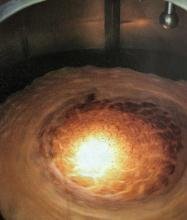How to brew beer?|如何酿造啤酒? |月旦评
前期给大家做了许多关于原材料的的分享,今天就给大家唠唠如何去酿造一款啤酒!
In the early stage, we have done a lot of sharing on raw materials for everyone. Today we will give you tips on how to make a beer!
首先,你需要根据你想要酿造的啤酒的类型去设计配方。(在有设备的前提下)
选择基础麦芽、特种麦芽、啤酒花、酵母等。(网上有很多的啤酒配方,可以去参照)
First, you need to design recipes based on the type of beer you want to brew. (under the premise of equipment)
Choose basic malt, specialty malt, hops, yeast, etc. (There are a lot of beer recipes online, you can refer to them)
一、麦芽粉碎 Malt mash
将称好重量的麦芽进行粉碎,要求麦芽皮破而不碎,胚乳越细越好。
The weighed malt is crushed and the malt is broken and not broken. The finer the endosperm, the better.
- 把麦皮从卖力表面分离,以便使它的胚乳有效的被酶分解。
- 减少胚乳变成粉状的程度。以增加它们吸收水分的有效面积。
- 有效的保持麦皮的完整,以便麦芽糖化后使麦汁的过滤顺利
- 从原材料中获得最高的收得率。
1、 The wheat husk is separated from the hard surface so that its endosperm is effectively decomposed by enzymes.
2、Reduces the degree to which the endosperm becomes powdery. To increase their effective area to absorb water.
3、Effectively maintain the integrity of the wheat husk so that the wort can be filtered smoothly after maltification
4、Get the highest yield from raw materials.
二、糖化 Saccharification
将粉碎的麦芽放入糖化锅,搅拌均匀形成醪液后开始升温糖化。
The crushed malt was placed in a mashing pot and stirred to form a mash, which was then warmed and saccharified.

糖化过程中的物质变化:
- 淀粉的分解(在63-65°C时 β-淀粉酶将淀粉分解为可发酵性糖-葡萄糖,72-75°C α淀粉酶将淀粉分解成不可发酵性糖-糊精等。)
- 蛋白质的降解(蛋白质在蛋白酶的作用下依次分解为高分子氮-影响啤酒的泡沫、物理及化学稳定性、啤酒的醇厚性;中分子氮-Co2的载体、影响杀口力;低分子氮、氨基酸-酵母的营养物质。)
- 磷酸盐的分解(磷酸脂酶可溶解麦芽中的一部分为溶解的有机磷酸盐,从而增加醪液的缓冲能力。)
- β-葡聚糖的分解(β-葡聚糖是构成啤酒酒体和泡沫性能的主要成分,β-葡聚糖过多会导致啤酒过滤的困难。)
- 多酚物质的分解
- 脂类的分解
- 锌的游离
Substance changes during saccharification:
1、Decomposition of starch (β-amylase breaks down starch into fermentable sugar-glucose at 63-65°C, and 72-75°C α-amylase breaks down starch into non-fermentable sugar-dextrin etc.)
2、 Degradation of proteins (proteins are broken down into macromolecule nitrogen under the influence of proteases) - Affects the foam, physical and chemical stability of beer, and the alcohol-thickness of beer; the carrier of medium molecular nitrogen-Co2 affects the killing power; low molecular nitrogen, Amino acids - yeast nutrients.)
3、 Decomposition of Phosphate (Phosphatase dissolves part of the malt as dissolved organic phosphate, which increases the buffering capacity of the mash.)
4、 Decomposition of β-glucans (β-glucans are the main components that make up the body and foam properties of beer. Excessive β-glucan can cause difficulties in beer filtration.)
5、 Decomposition of polyphenols
6、 Lipid decomposition
7、 Zinc free
糖化的方法主要有以下几种:
- 浸出糖化法(又分为单醪恒温浸出糖化法-糖化温度在65°C左右,糖化1~2h后升温至过滤温度78°C进行过滤;单醪升温浸出糖化法- 35°C-37°C时投料,浸泡原料,直接升温至50°C左右进行蛋白质分解,再缓慢升至65°C,72°C进行分段糖化,然后升温至78°C进行过滤;双醪浸出糖化法-糖化醪与糊化醪兑醪后,醪液不再煮沸,而是直接在糖化锅升温,打到糖化各阶段所需求的温度)。
- 煮沸糖化法-特点是将糖化醪液的一部分分批地加热到沸点,然后与其余未煮沸的醪液混合,使全部醪液温度分段地升温到不同酶作用所要求的温度。最后达到糖化终了温度。(又分为单醪煮出法、单醪删词煮出糖化法等。)
The main methods of saccharification are the following:
1、Leaching saccharification method (divided into single retort constant temperature leaching saccharification method - saccharification temperature of about 65 °C, saccharification 1 ~ 2h and then heated to a filtration temperature of 78 °C for filtration; single enthalpy temperature leaching saccharification - 35 °C -37 ° At the time of C feeding, immersing the raw materials, directly heating the protein to about 50°C to decompose, then slowly raising to 65°C, carrying out segmental saccharification at 72°C, then heating to 78°C for filtration; double mash leaching glycosylation-saccharification After mashing and gelatinizing, the mash is no longer boiled, but is heated directly in the mashing pot to the required temperature for each stage of mashing).
2、Boiling saccharification - It is characterized by heating a portion of the saccharified mash in batches to the boiling point and then mixing with the rest of the unboiled mash to raise the temperature of all the mash to a desired temperature for different enzymes. Finally reached the end of saccharification temperature. (It is divided into single-cooked boiled method, single-passed boiled saccharification method, etc.)
三、麦汁过滤 Wort filtration
麦汁过滤是为了得到澄清的麦汁。
Wort filtering is to get clarified wort.
- 将糖化醪液中已溶解的可溶物质和不溶性物质分离。
- 获得较高的浸出率。
1、Soluble soluble and insoluble substances in mash liquids are separated.
2、Obtain a higher leaching rate.
四、麦汁煮沸 wort boiling
- 酒花苦味物质的溶解和转化
- 可凝固性蛋白质-多酚复合物的形成和分离
- 蒸发多余水分,使麦汁达到规定的浓度
- 对麦汁进行灭菌
- 彻底破坏酶活性,固定麦汁成分
- 麦汁色度上升
- 麦汁酸度增加
- 还原性物质的形成
- 麦汁中的二甲基硫(DMS)和不良风味物质的去除
1、 Dissolution and transformation of bitter substances in hops
2、Formation and Separation of Coagulable Protein-polyphenol Complexes
3、Evaporate excess water so that the wort reaches the prescribed concentration
4、Sterilize wort
5、Complete destruction of enzyme activity, fixed wort ingredients
6、Wort color rises
7、Increased acidity of wort
8、Reducing substance formation
9、Removal of Dimethyl Sulfide (DMS) and Unpleasant Flavors in Wort
五、麦汁后处理 Wort post-processing
- 热凝固物的析出-随着蛋白质变性和多酚物质的氧化和聚合而洗出,同时吸附了部分酒花树脂及其它有机物
- 麦汁冷却-使麦汁温度达到酵母接种的要求
1、 Precipitation of thermal coagulum - washed out with protein denaturation and oxidation and polymerization of polyphenolic substances, while adsorbing some hop resins and other organics
2、Wort Cooling - Allows Wort Temperature to Meet Yeast Inoculation Requirements
麦汁通风:
1、麦汁冷却后进行通风操作
2、酵母吸收了充足的 氧气后,合成其繁殖所必需的甾醇和不饱和脂肪酸等物质。
Wort ventilation:
1. Vent after cooling the wort
2. After the yeast has absorbed enough oxygen, it synthesizes sterols and unsaturated fatty acids that are necessary for its reproduction.
七、啤酒发酵 Beer fermentation
啤酒发酵原理:
- 复杂的生物和物质转化过程
- 发酵的同时会产生部分发酵副产物:醇类、醛类、酸类、酮类和硫化物等物质。
- 决定了啤酒的分为、泡沫、色泽和稳定性等各项理化性能,赋予啤酒典型的特色。
Beer fermentation principle:
1、Complex biological and material transformation processes
2、Fermentation will also produce some of the fermentation by-products: alcohols, aldehydes, acids, ketones and sulfides and other substances.
3、It determines the various physical and chemical properties such as beer separation, foam, color and stability, and gives beer typical characteristics.
将麦汁中的可发酵性糖转化为乙醇和二氧化碳。
The fermentable sugar in the wort is converted into ethanol and carbon dioxide.
经过一段时间发酵后,得到未过滤的啤酒:
After a period of fermentation, unfiltered beer is obtained:
以上就是我为大家的分享,希望大家可以从中学到知识。如果您喜欢,欢迎给我点赞!
如果您有疑问,欢迎给我留言!
The above is what I share for everyone. I hope everyone can learn from it. If you like, welcome to give me a thumbs up!
If you have any questions, please leave me a message!

这个我倒是很感兴趣,有时间我也想试下如何动手自己做啤酒,给你赞一个
这个很简单。
回头给您教程。
Very interresting thank for sharing
Thank you!
@weitz, 这个月旦评不错,赞了!
谢谢您。
你好吗?什么?你还没参加 齐白石杯绘画大赛 吗?地球人都知道,对绘画感兴趣的朋友快快行动起来哟!奖金丰厚😊如果不想再收到我的留言,请回复“取消”。
我很好哦,谢谢您的关心!
最近几天因为没时间,所以没参加齐白石杯。
接下来会抽空参加的!
兄弟 厉害啊
还好
那果汁味的啤酒是怎麼弄得?
下次可以分享下嗎?;)
应该是直接加香精吧?😂
不知道
很神秘
可能是用witch 🧙♀️ stick 做的
嘿嘿嘿嘿嘿
现在啤酒,很少有去添加香精等这一类添加剂。
国内的cider都是在使用压缩果汁去酿造,煮沸过程中加入营养盐,等冷却后接种葡萄酒酵母就好了。
這個過程要多久呀
比一般的啤酒要快许多,一般是10-15天。
酵母的使用量决定发酵速度。
太贊了!!
泡沫好细腻的样子~
做的这款是小麦啤酒,泡沫洁白细腻是它应有的样子。
哈哈哈,不会分🤣
看得我都想喝一杯,捂脸